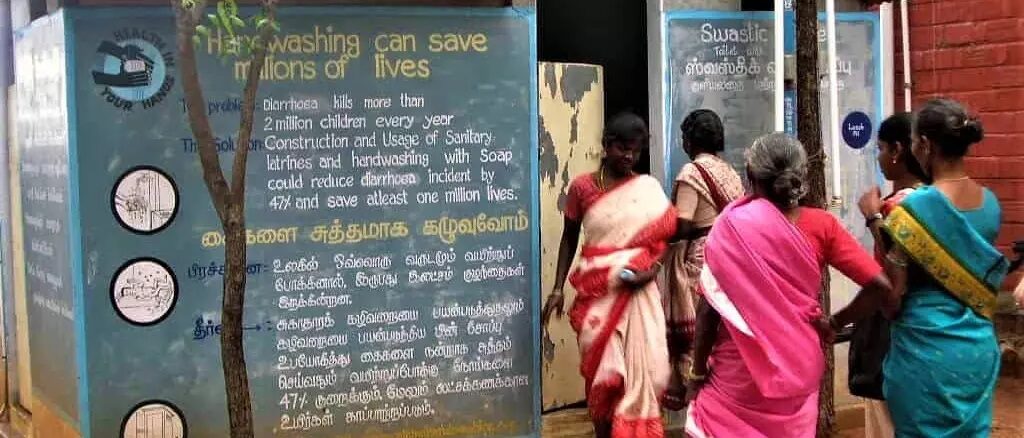Women Lead The Way To More Public Toilets In Odisha
Apr 29, 2023 | Pratirodh Bureau
Women's groups in Odisha are driving a movement to increase access to toilets in their homes and within their communities, with the aim of ending open defecation (Representational Image; by Binayak Das/ India Water Portal {CC BY-NC-SA 2.0})
Source: DW
Bedamati Mirdha of Nildungri village in Sambalpur, India, has been at the forefront of encouraging people in adjoining villages to construct a toilet at home instead of going out into the forest to defecate.
Two years back, as part of a women’s self-help group (SHG), Mirdha built a retrofitted twin pit toilet which has made a huge difference to her family.
“[Now] we do not worry about diseases and the many problems people face while defecating in the open. You must understand how important a toilet is in our lives,” Mirdha told DW.
Fighting To End Open Defecation
At the far end of the village, Prabhasini Munda, a cancer survivor, has a similar story after having built a toilet last year.
“There was always a fear of snakes and other poisonous insects in the open fields,” Munda told DW. “The problems worsened during the monsoon season and that is why I too decided that a toilet was a necessity.”
“We call it an izzat ghar (house of dignity) and womenfolk don’t have to fear any more,” added Munda.
The women went door-to-door to talk to villagers about better hygiene practices and told them about the government schemes that offer help with constructing toilets.
Open defecation has often led to increased vulnerabilities among girls and women, including verbal, physical and sexual violence affecting them both physically and psychologically.
Odisha Leading By Example
Across several rural parts of Odisha state, women SHGs are leading by example to ensure that toilets are built in homes without any resistance.
The drive is currently underway in six districts — Angul, Jagatsinghpur, Sambalpur, Deogarh, Koraput and Gajapati — with the aim of adding another 14 districts in the state.
Though the sanitation in rural areas is still poor, Odisha is among the top 5 states where a number of villages have been declared free of open defecation.
“UNICEF and Water.org have partnered with Odisha Livelihoods Mission, a government-run project to empower women by generating livelihoods by various trainings. In this way, the programme builds momentum and the community can lead it for long-term sustainability,” Surati Bada, an SHG leader, told DW.
Constructing a twin pit toilet can cost anywhere between 15,000 and 20,000 Indian rupees ($185-$244, €164-€ 222). Until now, 12,000 loans have been disbursed benefiting about 60,000 people, mostly for sanitation purposes.
“Financing is a great complementary tool to the government’s efforts for sustaining the momentum in bringing access to drinking water and sanitation for the economically active poor,” Abhishek Anand of Water.org told DW.
Stepping Up Toilet Construction
Until recently, people were not aware of affordable financing options for building and maintaining water, sanitation and hygiene assets. But the situation has now changed.
The retrofitted twin pit toilet ensures that the human waste is treated naturally, without polluting water bodies or the soil. The main feature of the toilet technology is the two pits that are used alternately, to ensure on-site faecal sludge management, making it a complete on-site sanitation solution for households.
Once a toilet gets constructed, SHGs monitor people to ensure they regularly use the facility and are not defecating in the open.
“Our dream is to provide toilets across the state. We take loans and government officials are cooperative in this regard. Many of the members are able to pay back within a year,” Sakuntala Mirdha, an SHG president told DW.
Toilets are arguably one of the most potent tools of women’s empowerment in history. Several studies show that an improvement in public sanitation reduces women’s time spent in care work by 10 per cent and also leads to high female literacy rates.
In several parts of the state, women are seen taking up traditionally unconventional roles, like masons and contractors engaged in toilet construction.
‘We started making concrete rings for the twin pit toilets and selling them to nearby villages as well. We are able to get additional income and this is an incentive for every toilet we help construct,” Soudamini, from Khulia village, told DW.
Empowerment of women is one of the key development initiatives identified by the Odisha government. Mission Shakti, a flagship programme of the state, has so far created more than 600,000 SHGs.
The Central government’s Swachh Bharat Mission or ‘Clean India’, created in 2014, aimed to give all urban local bodies in the country ‘open defecation-free’ (ODF) status by October 2019.
Now in order to sustain the ODF outcomes, the focus is on functionality and proper maintenance of community and public toilets, and addressing safe management of faecal sludge, ensuring that no untreated sludge is discharged into water bodies.
Sujoy Mojumdar, a water sanitation and hygiene specialist at UNICEF, pointed out that this initiative is contributing to the provision of safely managed sanitation. This includes safe toilets and water services to all, while also promoting the economic empowerment of women through livelihood programs ensuring their family well-being in the long run.
“It also makes (for) long-term sustainable income generation opportunities for the trained women technicians like masons, plumbers and sanitation entrepreneurs,” Mojumdar told DW.
